Restenosis Inhibition and Re-differentiation of TGFβ/Smad3-activated Smooth Muscle Cells by Resveratrol
- PMID: 28165488
- PMCID: PMC5292946
- DOI: 10.1038/srep41916
Restenosis Inhibition and Re-differentiation of TGFβ/Smad3-activated Smooth Muscle Cells by Resveratrol
Abstract
To date, there is no periadventitial drug delivery method available in the clinic to prevent restenotic failure of open vascular reconstructions. Resveratrol is a promising anti-restenotic natural drug but subject to low bioavailability when systemically administered. In order to reconcile these two prominent issues, we tested effects of periadventitial delivery of resveratrol on all three major pro-restenotic pathologies including intimal hyperplasia (IH), endothelium impairment, and vessel shrinkage. In a rat carotid injury model, periadventitial delivery of resveratrol either via Pluronic gel (2-week), or polymer sheath (3-month), effectively reduced IH without causing endothelium impairment and vessel shrinkage. In an in vitro model, primary smooth muscle cells (SMCs) were stimulated with elevated transforming growth factor (TGFβ) and its signaling protein Smad3, known contributors to IH. TGFβ/Smad3 up-regulated Kruppel-like factor (KLF5) protein, and SMC de-differentiation which was reversed by KLF5 siRNA. Furthermore, TGFβ/Smad3-stimulated KLF5 production and SMC de-differentiation were blocked by resveratrol via its inhibition of the Akt-mTOR pathway. Concordantly, resveratrol attenuated Akt phosphorylation in injured arteries. Taken together, periadventitial delivery of resveratrol produces durable inhibition of all three pro-restenotic pathologies - a rare feat among existing anti-restenotic methods. Our study suggests a potential anti-restenotic modality of resveratrol application suitable for open surgery.
Conflict of interest statement
The authors declare no competing financial interests.
Figures
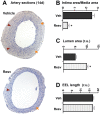

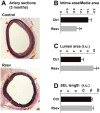
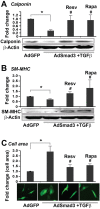
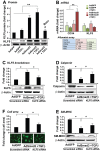
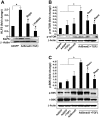


Similar articles
-
Local CXCR4 Upregulation in the Injured Arterial Wall Contributes to Intimal Hyperplasia.Stem Cells. 2016 Nov;34(11):2744-2757. doi: 10.1002/stem.2442. Epub 2016 Jul 17. Stem Cells. 2016. PMID: 27340942 Free PMC article.
-
TGF-β and Smad3 modulate PI3K/Akt signaling pathway in vascular smooth muscle cells.Am J Physiol Heart Circ Physiol. 2012 Jun 1;302(11):H2211-9. doi: 10.1152/ajpheart.00966.2011. Epub 2012 Mar 23. Am J Physiol Heart Circ Physiol. 2012. PMID: 22447946 Free PMC article.
-
TGF-β/Smad3 inhibit vascular smooth muscle cell apoptosis through an autocrine signaling mechanism involving VEGF-A.Cell Death Dis. 2014 Jul 10;5(7):e1317. doi: 10.1038/cddis.2014.282. Cell Death Dis. 2014. PMID: 25010983 Free PMC article.
-
TGF-beta through Smad3 signaling stimulates vascular smooth muscle cell proliferation and neointimal formation.Am J Physiol Heart Circ Physiol. 2009 Aug;297(2):H540-9. doi: 10.1152/ajpheart.91478.2007. Epub 2009 Jun 12. Am J Physiol Heart Circ Physiol. 2009. PMID: 19525370 Free PMC article.
-
A crosstalk between TGF-β/Smad3 and Wnt/β-catenin pathways promotes vascular smooth muscle cell proliferation.Cell Signal. 2016 May;28(5):498-505. doi: 10.1016/j.cellsig.2016.02.011. Epub 2016 Feb 19. Cell Signal. 2016. PMID: 26912210 Free PMC article.
Cited by
-
Pharmacological and toxicological roles of Kruppel-like factors (KLFs) in the cardiovascular system: a review.Mol Biol Rep. 2025 May 26;52(1):506. doi: 10.1007/s11033-025-10613-0. Mol Biol Rep. 2025. PMID: 40418318 Review.
-
Noncoding RNAs in Vascular Cell Biology and Restenosis.Biology (Basel). 2022 Dec 22;12(1):24. doi: 10.3390/biology12010024. Biology (Basel). 2022. PMID: 36671717 Free PMC article. Review.
-
Therapeutic Effects of Resveratrol Liposome on Muscle Injury in Rats.Med Sci Monit. 2019 Apr 2;25:2377-2385. doi: 10.12659/MSM.913409. Med Sci Monit. 2019. Retraction in: Med Sci Monit. 2022 Oct 19;28:e938688. doi: 10.12659/MSM.938688. PMID: 30936416 Free PMC article. Retracted.
-
Hyperinsulinemia-induced KLF5 mediates endothelial angiogenic dysfunction in diabetic endothelial cells.J Mol Histol. 2019 Jun;50(3):239-251. doi: 10.1007/s10735-019-09821-3. Epub 2019 May 2. J Mol Histol. 2019. PMID: 31049798
-
Current knowledge of Krüppel-like factor 5 and vascular remodeling: providing insights for therapeutic strategies.J Mol Cell Biol. 2021 May 7;13(2):79-90. doi: 10.1093/jmcb/mjaa080. J Mol Cell Biol. 2021. PMID: 33493334 Free PMC article. Review.
References
-
- Ichimoto E. et al.. Mechanism of edge restenosis after sirolimus-eluting stent implantation. J Invasive Cardiol 24, 55–57 (2012). - PubMed
-
- Holy E. W. et al.. PI3K/p110alpha inhibition selectively interferes with arterial thrombosis and neointima formation, but not re-endothelialization: potential implications for drug-eluting stent design. European heart journal 35, 808–820 (2014). - PubMed
Publication types
MeSH terms
Substances
Grants and funding
LinkOut - more resources
Full Text Sources
Other Literature Sources
Miscellaneous

